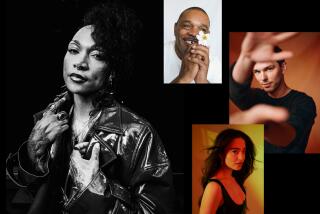The faces of destiny
- Share via
Birth control crusader Margaret Sanger appears in one corner, Hollywood darlings Mary Pickford and Lillian Gish in another. A crane-necked Martha Graham dwells not far from a scowling Emma Goldman. Billie Holiday is here, emerging from a shadow, and Grandma Moses there, gazing wistfully past the curtains of her New York state farmhouse, while a little farther on Julia Child pauses beneath a curtain of Italian sausages in a crowded Boston market.
Viewed individually, the 70-plus faces that line the walls of “Women of Our Time: Twentieth-Century Photographs From the National Portrait Gallery,” now at the Long Beach Museum of Art, have little in common besides their gender and relative name recognition.
Collectively, however, they bear witness to one of the most dramatic social shifts of the turbulent 20th century: the wide-scale emergence of women into the public sphere of American life.
The actual history of this shift, of course, is long and extremely complicated, its advances fraught with struggle and its progress far from complete, considering the disproportionately low number of women in Congress, leading corporations or directing feature films.
“Women of Our Time” presents a notably simplified version of this story, pairing each image with a short, anecdotal biography but offering little in the way of overview. One in a series of traveling exhibitions intended to showcase the collection of the National Portrait Gallery while that building is closed for renovation, the show has some stake in promoting the value of portraiture as a genre and the tone is understandably celebratory. Each face is presented as a document unto itself, each subject a brick in the growing edifice of American culture.
Think of it as history in cocktail party form, offering viewers an opportunity to mingle with important people, gaze unreservedly upon famous faces and gather snippets of edifying conversation.
There are considerable limitations to such an approach -- we learn only so much about the forest by focusing exclusively on the trees -- but the show accomplishes a great deal within them, thanks in large part to the consistently riveting quality of the images themselves. These aren’t merely exceptional women, but exceptional women viewed through the eyes, in most cases, of outstanding photographers: Edward Steichen, Berenice Abbott, Carl Van Vechten, Lisette Model, Arnold Newman, Irving Penn and others.
In presenting such a range of styles and tendencies, moreover -- from the staid formality of Victorian portraiture to the sharp lines of Steichen’s modernism to the drama of Hollywood publicity shots -- the show says as much about the ongoing development of photographic language as it does about the personalities of the individual women.
The selection is far from encyclopedic, leaning notably toward the more commonly documented spheres of society, such as entertainment, fashion and sports. (As curator Frederick Voss states frankly in the catalog, the museum has been collecting photographs only since the mid-1970s and gaps inevitably remain.) But each image clearly has been chosen with care, whether for historical significance, aesthetic value or, most often, some combination of the two.
What the show lacks in scope, then, it makes up in curatorial integrity.
The approaches range from candid to self-consciously stylized, with noteworthy examples across the spectrum.
The candid shots are memorable for the glimpse they offer into the activities for which their subjects are best known. We see Joan Baez, for example, waiting attentively with her guitar in the wings of the 1963 civil rights demonstration in Washington; Janis Joplin howling fiercely in the onstage darkness of a New York concert; the Supremes twisting and swaying in a brightly lighted recording session; and Marilyn Monroe crooning for a mob of eager Korean War soldiers (in a photograph taken by a Navy medic lucky enough to find a seat near the front).
One Garry Winogrand image portrays a somber Diane Arbus with a daffodil stem clamped rather absurdly between her lips, taking photographs in the littered aftermath of an antiwar protest. Charmian Reading captures civil rights activist Fannie Lou Hamer, sweat cascading down her dark, round face, in the midst of what looks to be a soul-stirring anthem. And, in one of the show’s most beautiful images, Model depicts dancer and choreographer Pearl Primus -- who referred to dance, according to the wall text, as “the fist with which I fight the sickening ignorance of prejudice” -- suspended between spotlight and shadow in a wave of intoxicatingly sensual movement.
Among the posed photographs, some are elegant (such as Louise Dahl-Wolfe’s image of willowy stage actress Katharine Cornell), others stately (Clara E. Sipprell’s portrait of a grandmotherly Eleanor Roosevelt), others sexy (Nickolas Muray’s depiction of dancer Doris Humphrey in a wig of simulated seaweed and a very scant little sheath) or humorous (Esther Bubley’s Time magazine picture of poet Marianne Moore mingling with the elephants of the Bronx Zoo).
Some of the works offer clear testament to the qualities for which their subjects are known. Vivian Cherry’s portrait of Catholic Worker founder Dorothy Day, for example, gives a powerful sense of that woman’s solemnity, compassion and determination. Others, however, reveal only a facet of what we know to be true. In Rollie McKenna’s photograph of Anne Sexton, for instance, the poet’s glamorous appearance and easy smile belie the ongoing emotional turmoil that would lead to her suicide 13 years later.
The most memorable photographs in the show, candid or posed, are by and large the most spare: those in which, by whatever blend of artistry and chance, the face of the subject emerges with stirring clarity. These include Joseph T. Keiley’s turn-of-the-century portrait of Native American reformer Gertrude Simmons Bonnin (Zitkala-Sa), whose sad, beautiful eyes speak volumes about the shadows of American history; Irving Penn’s famous image of a 61-year-old Georgia O’Keeffe, who, though physically backed into a corner, confronts viewers with the commanding presence of royalty; and George Platt Lynes’ stark, wistful portrait of Dorothy Parker, whose slightly hunched form seems a barely contained bundle of raw emotion and intelligence.
Bob Willoughby’s 1954 image of Judy Garland on the set of “A Star Is Born,” which depicts nothing but the actress sitting alone against a white wall, somehow manages to convey both the legendary vitality of her presence and the renowned turmoil of her inner life and surely ranks with the best celebrity photography of all time. Rollie McKenna’s 1959 portrait of a schoolgirlish Sylvia Plath is equally simple and equally beguiling. Though I couldn’t say why -- these things are mysterious and no doubt largely subjective -- it’s the one I have the hardest time pulling my eyes away from.
These portraits make for stimulating company. It’s unlikely that the show will radically alter your opinions about women’s history or even teach you much that you didn’t already know. But it would take a hardhearted person to leave feeling uninspired. It’s a feel-good show, you might say, but one devoted to a topic that’s worth feeling good about.
*
‘Women of Our Time’
Where: Long Beach Museum of Art, 2300 E. Ocean Blvd., Long Beach
When: Tuesdays to Sundays, 11 a.m. to 5 p.m.
Ends: April 4
Price: $5
Contact: (562) 439-2119
More to Read
The biggest entertainment stories
Get our big stories about Hollywood, film, television, music, arts, culture and more right in your inbox as soon as they publish.
You may occasionally receive promotional content from the Los Angeles Times.










